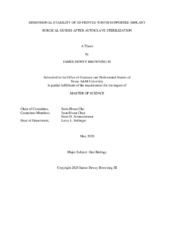| dc.description.abstract | 3D printed surgical guides for dental implant placement must be sterilized prior to use for patient safety. It is of clinical interest to know if surgical guides suffer distortion during the sterilization process. However, there is limited data evaluating the distortion resulting from the manufacturer’s recommended sterilization protocol. The purpose of this in vitro study was to evaluate the effect of autoclave sterilization on the dimensional stability of 3D printed tooth-supported implant surgical guides. Twenty surgical guides were made with 3D printing resin in an SLA printer, and were split into two groups (n=10). Group L consisted of long-span guides including the teeth from first molar to first molar of maxillary arch. Group S consisted of short-span guides including the teeth from canine to canine of maxillary arch. All the guides were designed for placing a single implant at the left central incisor position. No other teeth were missing. After 3D printing, the surgical guides were washed, cured, and the print supports were trimmed. A metal bolt was secured in the guide tube position. After scanning the guides in a laboratory scanner as controls, the guides were sterilized by autoclave according to the resin manufacturer’s recommendation (121ºC, 104 kPa, 30 minutes). The post-sterilization scans were aligned either on the bolt or on the cusps to compare with the pre-sterilization scans. For statistical analysis, Mann-Whitney U tests were run on independent samples (α = .05).
There were consistent patterns of distortion typically observed in the apical direction of the teeth. In addition, greater deviations appeared on the distal extensions of group L. When aligning samples on the bolt, there were statistically significant differences of deviations between scans at the distal-most sites of group S and group L (P < .001), while there was no significant difference of deviations at the canine sites between two groups (P = .631). When aligning samples on the cusps, the group L exhibited significantly greater deviations in bolt angle (P < .001) and apical point position (P < .001) than those of the group S. There were significant differences of distortion at the distal-most sites between group L and group S. However, there was no significant difference of distortion up to the canine areas for both groups. Group L demonstrated significant angular distortion of the implant drill guide tube and significant apical location distortion in comparison with group S. Unnecessary extension of 3D printed surgical guides should be avoided to prevent the potential degree of surgical guide distortion by autoclave sterilization process. | en |


